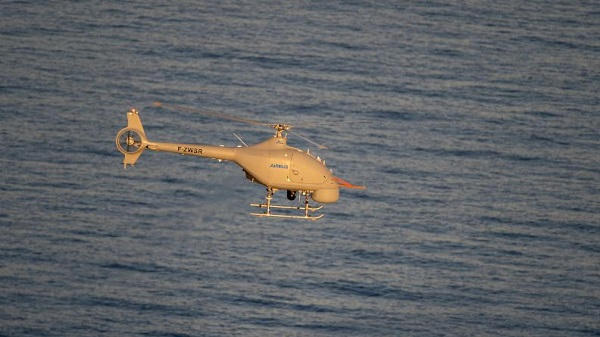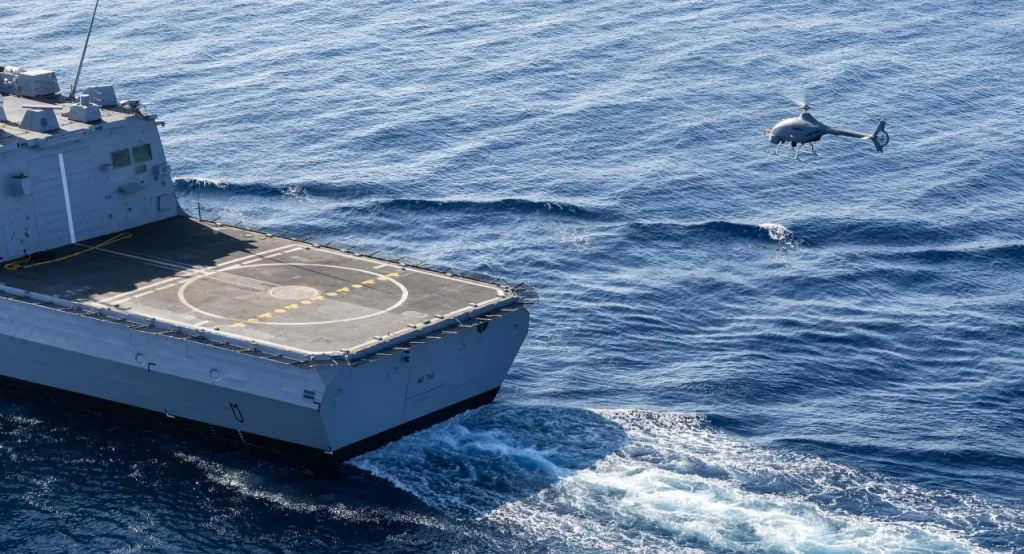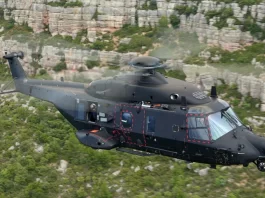Airbus Helicopters and Naval Group announced on October 31 that the SDAM demonstrator (System de Drone Aérien Marine/Naval Aerial Drone System) had been tested from a multi-mission frigate (FREMM) in collaboration with the French Armament General Directorate, DGA (Direction génerale de l’armement), and the French Navy. The exercises were conducted from October 2 to October 9 in the Mediterranean Sea aboard the French Navy frigate Provence. The Naval Group had previously modified the vessel to accommodate the SDAM. These sea trials were organised to showcase the SDAM’s capabilities for surveillance and intelligence missions and the system’s superior performance from an operational warship.
Currently, the SDAM programme is being executed using the VSR-700 demonstrator, a derivative of the Cabri G2 light civil helicopter manufactured by Guimbal. Alongside developing an additional device that can be utilised by surface ships, the organisation is confronted with validating a technology designed to facilitate autonomous frigate landings regardless of sea conditions. Based on the Deckfinder system, this technology enables autonomous drone launch and recovery with an accuracy of 10 to 20 cm in challenging conditions, independent of satellite positioning systems [GNSS/GPS], as stated by Airbus Helicopters.

With a range of 150 kilometres and an endurance of eight hours, the SDAM/VSR-700’s 145 horsepower engine must enable it to travel at an altitude of 5,000 metres at a speed of 185 kilometres per hour. A Diades C-Ranger 200 radar, a Wescam MW-10 optronic ball, an AIS receiver, SonoFlash acoustic buoys will be installed on board. Additional cargoes might be investigated and evaluated during SDAM programme development.
The CEO of Airbus Helicopters, Bruno Even, stated that the proposed system could be adapted to the naval missions for which it was designed and operated from a frigate. He expressed that the organisation is eager to showcase the capabilities of its system further and to establish a partnership with the French Navy to provide an initial operational capability by 2026.
The trials represent a significant milestone in the enhancement of the French Navy’s future capabilities, and the company surpassed a noteworthy milestone in terms of the physical and operational complexity of integrating an unmanned aerial system (UAS) aboard a heavily armed vessel, according to Naval Group CEO Pierre-Eric Pommellet. He added that these trials have demonstrated the utility of the Naval Group I4Drones mission system and that the SDAM demonstrator is compatible with other existing systems and can be seamlessly integrated into a vessel. He further stated that the drone, operating with the ship’s combat system and the embarked helicopter, will be an additional method to penetrate complementary airspaces and function as a remote sensor that enhances the crew’s real-time threat perception and response.

The derisking study for the SDAM programme was awarded to Airbus Helicopters and Naval Group by the DGA in 2017. The objective is to design, produce and test a rotary wing unmanned aerial system demonstrator for the French Navy. The system works with the Airbus Helicopters VSR700 unmanned aerial system and the I4Drones mission system developed by Naval Group. The Naval Group has also been tasked with integrating the system onboard military vessels. The project also involves French SMEs like Hélicoptères Guimbal and Diades, contributing to creating a local naval UAS industry in France.
The Military Programming Law [LPM] 2024-30 stipulates that eight SDAMs must be procured by 2030 to outfit all first-rate vessels with them by 2035, amounting to a minimum of fifteen units.






